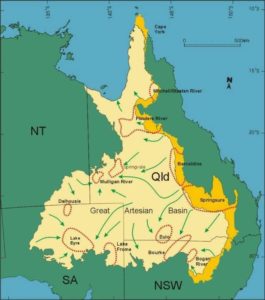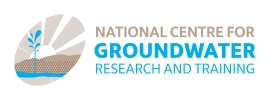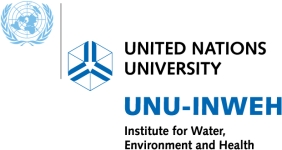Ensuring long-term services from a mega aquifer system under pressure
Why is the Great Artesian Basin important, and what has been done?
The Great Artesian[i] Basin (GAB) is the largest underground water resource in Australia. It is the main source of water for pastoralists, petroleum and mining industries, homesteads, towns and indigenous settlements in arid and semi-arid central and eastern Australia. Artesian springs from the GAB (Figure 1) support nationally significant groundwater-based environmental assets, including unique flora and fauna. The GAB is threatened by large-scale use from the pastoral, mining and petroleum industries, including wastage caused by the inefficient diversion and distribution of constantly flowing artesian water by open earth channels used by the pastoral industry. The Australian and state governments have developed programs in collaboration with stakeholders to rehabilitate flowing artesian water bores and introduce piped distribution systems in order to alleviate serious drawdown of the artesian pressure and protect GAB water resources and ecosystems.

Figure 1. Great Artesian Basin (showing main artesian spring groups and flow paths) (source: Fensham and Fairfax 2003 [7])
After the discovery of the basin’s artesian groundwater resources in 1878, more than 1,500 bores had been drilled by 1918, and there was already evidence of falling artesian pressure across the basin. The early introduction of state-based licensing regulations was unable to stem the wastage of GAB water and the loss of artesian pressure. At present, about 5,000 flowing artesian bores (Figure 2) and about 25,000 non-flowing (pumped) artesian bores sourced from the basin’s aquifers support human uses. Groundwater levels have fallen by up to 100 m in some areas, with some artesian bores and springs ceasing to flow and reduced discharges from other flowing bores and springs. The introduction of large amounts of water in the arid and semi-arid regions has caused land degradation, proliferation of invasive species and loss of unique flora and fauna.

Figure 2. The Great Artesian Basin, Australia – Uncontrolled flowing artesian waterbore (photo: M. A. Habermehl).
Solutions and remedial programs
A Strategic Management Plan for the GAB was presented in 2000 by the Great Artesian Basin Consultative Council and endorsed by the Australian, New South Wales, Queensland, South Australia and Northern Territory governments [2]. The council consisted of representatives from the federal, state and local governments; pastoral, petroleum and mining industries; traditional landholders; bore owners; and community and conservation groups. The plan included measures to address basin-wide management issues, sustainable development and use of the artesian groundwater.
The Australian and state governments had previously instituted two important programs to rehabilitate unserviceable and corroded artesian water bores and eliminate wastage through the use of open earth distribution channels: the Great Artesian Basin Bore Rehabilitation Program (GABBRP) 1989-1999 and the Great Artesian Basin Sustainability Initiative (GABSI) 1999-2017. Both programs were financed largely by the federal and state governments, with minor contributions from the bore owners. The GABBRP aimed to eliminate or reduce the large number of uncontrolled flowing artesian water bores by installing or replacing control valves, headworks and broken or corroded bore casings, and to reduce the wastage of water by replacing open earth bore distribution drains by polythene pipes, tanks and troughs, thereby reducing seepage, transpiration and evaporation of water (Figure 3) [3]. In the period 1989-2017, nearly 1,250 uncontrolled or degraded water bores were rehabilitated, representing a water saving of about 300,000 million liters per year, almost half of the total bore discharge. The GABSI program alone accelerated bore rehabilitation, saving about 250,000 million liters per year of artesian groundwater. The GABBRP and GABSI programs resulted in a significant recovery in artesian pressure with several meters of improvement in pressure heads in several large regions of the GAB in recent years, which is benefitting artesian springs and associated groundwater-dependent ecosystems [2] [3] [4] [5] [6].
In addition, the (Australian government) Environment Protection and Biodiversity Conservation (EPBC) Act 1999 now provides legislated protection for nationally significant natural infrastructure and environmental assets dependent on the GAB artesian springs, including several endangered flora and fauna species. The EPBC Act is also the main tool for regulating larger developments by the states and Australian government in particular for mining and petroleum developments.

Figure 3. The Great Artesian Basin, Australia – Controlled and piped flowing artesian waterbore (photo: M. A. Habermehl).
Lessons learned and further challenges
A summary of lingering challenges related to GAB protection and management have been listed [2]. Despite increasing emphasis on valuing groundwater, non-commercial benefits of the GAB remain undervalued. Resource allocation and management decisions are based largely on values of groundwater for economic production; hence there is often a shortage of information on indigenous, social, environmental and cultural heritage values.
The history of GAB management exemplifies and underlines the importance of early intervention, long-term commitment, and collective action in order to research, understand, measure, monitor and protect important groundwater resources and their services to humans and nature. The benefits of even large groundwater resources such as the GAB are not immune to over-abstraction and degradation. Long-term programs to improve grey infrastructure to access groundwater and reduce wasteful discharges and hence protect the natural infrastructure of the artesian aquifers, expressed as springs and free-flowing water bores, have generally been effective, and this action needs to be sustained or expanded to non-serviced areas. Increased effort and resources are needed to assess indigenous, social and environmental and cultural heritage values, and to give these values greater weight in decision making, especially in an era of increased demand on the GAB from various economic developments, like mineral and energy extraction, and in an increasingly variable and uncertain climate.
[i] Artesian groundwater is groundwater under pressure in a confined aquifer, which in a drill-hole will rise naturally to above the top of the aquifer or the ground surface, and in the latter case produce free flowing artesian bores.
[1] Habermehl, M.A. 2018. Groundwater governance in the Great Artesian Basin, Australia. Chapter 21 in: Advances in groundwater governance, eds., Villholth, K.G.; López-Gunn, E.; Conti, K.; Garrido, A; van der Gun, J. London, UK: Taylor & Francis Group. Pp. 411-441.
[2] Great Artesian Basin Consultative Committee. 2000. Great Artesian Basin strategic management plan. Canberra: Australian Government. http://www.gabcc.gov.au/sitecollectionimages/resources/17686c7e-ebe2-4701-b41d-1397b6c85972/files/strategic-mgt-plan-2000.pdf See also: http://www.gabcc.gov.au/basin-management/key-issues (accessed April 24, 2018).
[3] Commonwealth of Australia. 2015. Future directions for the management of the Great Artesian Basin: A review of the strategic management plan.
http://www.gabcc.gov.au/sitecollectionimages/resources/dfd46067-0d59-4056-a51d-29f641bfcc4e/files/gab-future-directions.pdf (accessed May 5, 2018).
[4] National Water Commission. 2013. Allocating water and maintaining springs in the Great Artesian Basin. Volume VII: Summary of findings for natural resource management of the Western Great Artesian Basin. Canberra: National Water Commission.
[5] Cox, R.; Barron, A. 1998. Great Artesian Basin resource study. Great Artesian Basin Consultative Council.
[6] Macauley, S.; Carey, H.; Habermehl, M.A. 2009. Technical report – Artesian pressure trends within the Great Artesian Basin. Canberra: Bureau of Rural Sciences.
[7] Fensham, R.J.; Fairfax, R.J. 2003. Spring wetlands of the Great Artesian Basin, Queensland, Australia. Wetlands Ecology and Management 11(5): 343-362.
A. (Rien) Habermehl1 and Andrew Ross2
1 (Previously) Geoscience Australia and Bureau of Rural Sciences, Australia; Email: rien.habermehl@grapevine.com.au
2 Australian National University (ANU), Australia





































